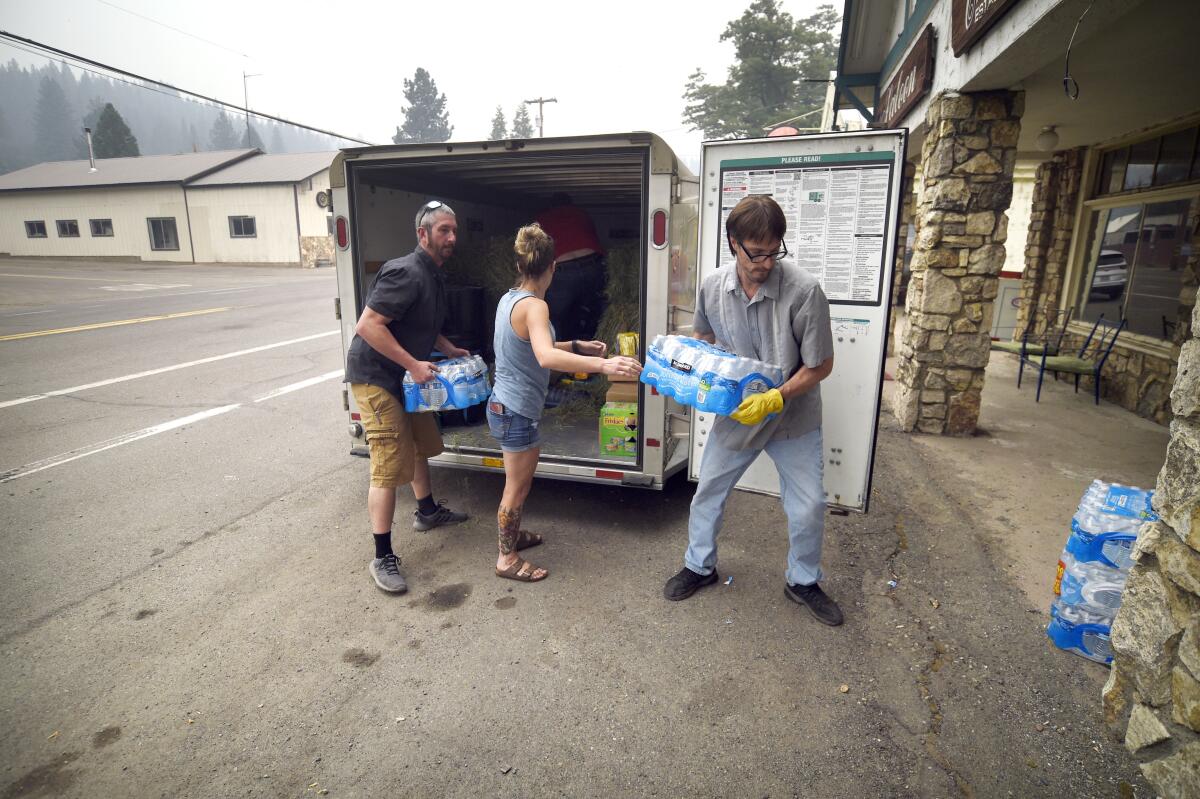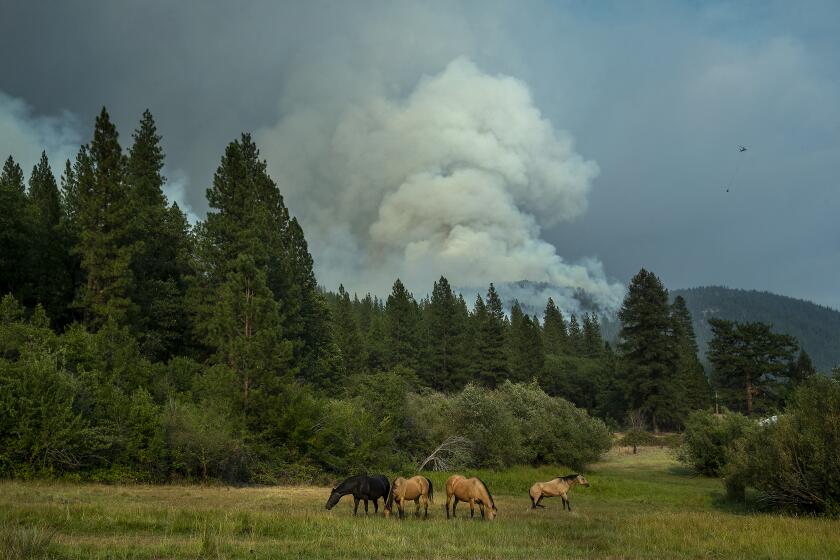PG&E threatens power shutoffs as Dixie fire rages in Northern California

- Share via
As the Dixie fire continues to rage, Pacific Gas & Electric Co. announced that it could cut power for roughly 39,000 residents across 16 Northern California counties Tuesday night to reduce the risk of wildfires from energized power lines.
Strong southwest winds were expected to arrive in the northern part of the state Monday, colliding with searing temperatures and parched vegetation — a cocktail of conditions known to stoke extreme fire behavior.
A red flag warning for the Dixie burn area is expected to last through 10 p.m. Tuesday, as gusts are expected to peak at 35 mph. Temperatures will hover in the mid-90s, potentially hitting triple digits in some areas.
PG&E began alerting customers about the possible shutoffs on Sunday through text, email and automated calls.
The utility has said its equipment may have sparked the massive Dixie fire, which broke out July 13 near where a tree fell into a power line. It took a worker about 10 hours to reach the remote site and observe flames, company officials said.
Nine days after the Dixie fire started, PG&E equipment may have ignited the Fly fire nearly 30 miles to the northeast, a blaze that eventually merged with Dixie.
As of Monday morning, Dixie covered a monstrous 569,707 acres, growing roughly 50,000 acres since Friday. After burning for more than a month, it is only 31% contained. It is the second-largest wildfire in California history.
More than a month after it ignited near a Pacific Gas and Electric Co. power station, the Dixie fire rages on
PG&E said in a news release that the planned shutoffs are a preemptive step to tamp down risk amid the dangerous weather conditions.
Most of the residents in the potential shutoff area — about 27,000 — are in Butte and Shasta counties, PG&E said in a news release. However, residents in 14 other counties — Glenn, Humboldt, Lake, Lassen, Mendocino, Napa, Plumas, Sierra, Solano, Sonoma, Tehama, Trinity, Yolo and Yuba — may also be affected.
Temperatures could top 100 degrees Monday in parts of Butte and Shasta counties. Smoke will envelope both counties, and plumes continue to plague areas far from the burn sites. A 48-hour smoke advisory of unhealthy air quality was issued Monday for the Antelope Valley — an area more than 400 miles south of the Dixie fire.
Although the cause of the fire remains under review, prosecutors in at least two counties are investigating PG&E for potential criminal charges, saying the utility should have been aware of the high risk of fire in the canyon. It is the same canyon where PG&E equipment ignited the 2018 Camp fire. In that blaze, the utility pleaded guilty to 84 counts of manslaughter after the town of Paradise was decimated.
PG&E had planned to bury the power line that might have started the Dixie fire as part of a safety campaign announced in the wake of the Camp fire, but work on the project hadn’t yet begun.
The Dixie fire has torched parts of Plumas, Lassen, Tehama and Butte counties, forcing thousands to evacuate.
The blaze leveled the remote Gold Rush town of Greenville and has destroyed at least 1,173 structures, including more than 630 homes, according to the latest incident report. More than 14,800 structures remain threatened by the flames.
Another blaze, the Morgan fire, merged Sunday with the northwestern portion of the Dixie fire, expanding it by several hundred acres, fire spokesperson David Janssen said.
The second-largest California wildfire has burned more than 500,000 acres. See the remains through the smoke and ash.
With fierce winds approaching, there is concern the blaze will continue its expansion.
“A lot of these lines will be tested today,” Janssen said Monday, “and it’s going to be pushing pretty hard up there on that north end.”
Toward the north lies the Lassen National Forest, as well as the Lassen Volcanic National Park, where flames arrived in early August and forced the park’s closure.
“It’s a treasure up there,” Janssen said of the park, noting that the fire has rapidly expanded through forested areas.
The Dixie fire has destroyed timber worth more than $1 billion. Still under threat is additional timber worth $1 billion, according to the U.S. Forest Service.
Several other wildfires are ravaging Northern California, including the Monument and McFarland fires, which are burning to the northwest of the Dixie fire and were sparked in late July by lightning.
The Monument fire had chewed through 97,287 acres by Monday and was 10% contained. A new evacuation order was issued for the Barker Mountain area and northwest of Hayfork Summit, with additional places under evacuation warnings. Details can be found on the Trinity County Sheriff’s Office Facebook page.
The McFarland fire — at 51,909 acres and 68% contained — continued to prompt evacuations Monday in three counties.
The Shasta County Sheriff’s Office announced mandatory evacuations for the community of Platina, including all residences and roadways from the Trinity-Shasta county line to the Shasta-Tehama county line.
A temporary evacuation point was opened at Shasta County’s Igo Ono Platina Union Elementary for those fleeing the fire, a regional chapter of the American Red Cross announced in a tweet.
Nevada Assemblywoman Michelle Gorelow tweeted a photo of the McFarland fire glowing orange over her husband’s cabin early Monday, followed several hours later by an image of evacuations underway.
“Be safe everyone!” she wrote.
More than 10,700 firefighters are battling 10 large wildfires across California that, combined, have burned more than 1 million acres, according to the California Department of Forestry and Fire Protection. Nationwide, 97 large fires and complexes have scorched more than 2 million acres, according to the National Interagency Fire Center, or NIFC.
It’s still early in the fire season, and new blazes continue to crop up.
Around 7 p.m. Saturday, what’s been named the Caldor fire sprang up in El Dorado County, roughly four miles south of Grizzly Flats and two miles east of Omo Ranch, according to an incident report.
Less than two days later, the fire had burned 754 acres through heavy timber and up steep terrain, spurring mandatory evacuation orders for Leoni Meadows and Big Mountain.
The concurrent blazes have strained personnel and access to basic necessities such as food and water, fire officials said.
The National Multi-Agency Coordinating Group within the NIFC, which works with local officials to prioritize needs and resources, recently issued memos warning of a shortage of radio communications equipment and advising firefighters arriving at incidents to bring enough food and water for three days because of high demand on caterers, bottled water and shower units.
The memos affect firefighters who are responding to large, team-managed fires, said Carrie Bilbao, a public information officer.
All of the caterers contracted by the government to feed those at large incidents were already working, so the group had to hire local caterers through an emergency equipment order, Bilbao said.
“It sounds like there are more caterers becoming available, so it should be good,” Bilbao said Sunday. “But until they lift it, and as long as we continue to see a high need for resources, they just want everyone to be prepared.”
The demand on radio equipment is in part caused by the sheer size of some of the fires, she said.
Bilbao said it’s not unusual for authorities to face resource limitations when the NIFC is operating at Preparedness Level 5, meaning that at least 80% of the country’s incident management teams and wildland firefighters are deployed.
This year, the NIFC entered its highest preparedness level on July 14, versus Aug. 18 last year — meaning that as the West enters peak fire season, many have already been battling large blazes for a month.
Bilbao said officials are aware of reports of personnel shortages but noted that the 25,000 people fighting fires across the country as of Sunday remained below last year’s peak of 32,000.
It’s difficult to determine whether there’s a shortage, she said. “Especially when you have multiple geographic areas having multiple fires, resources are kind of spread thin, because they’re needed across multiple areas,” she said.
That contrasts with previous years, when only one or two areas were “in dire need,” and resources could be shifted accordingly.
“This year, we’re seeing more need in multiple areas all at once, and so that’s what has been unusual,” she said.
More to Read
Sign up for Essential California
The most important California stories and recommendations in your inbox every morning.
You may occasionally receive promotional content from the Los Angeles Times.












